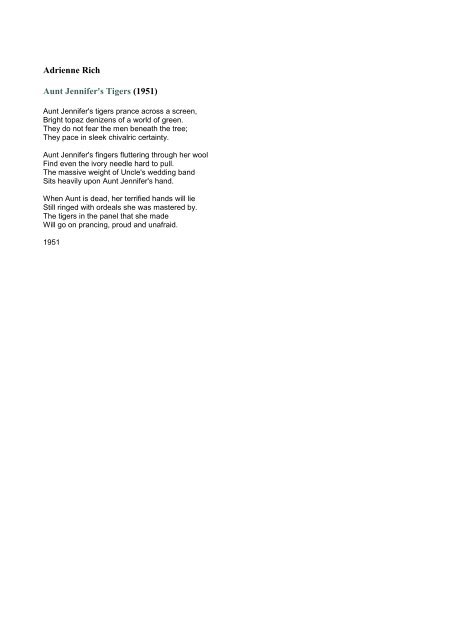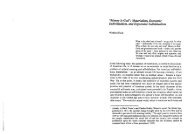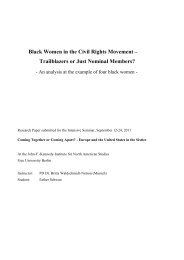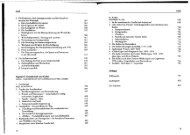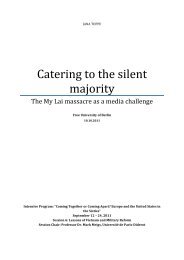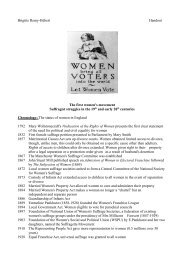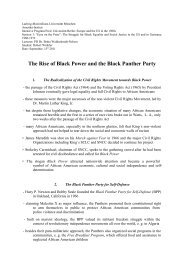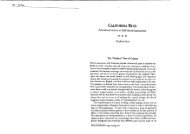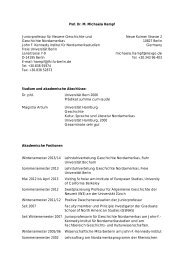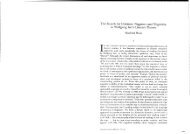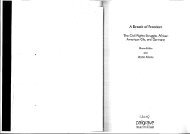Adrienne Rich Aunt Jennifer's Tigers (1951)
Adrienne Rich Aunt Jennifer's Tigers (1951)
Adrienne Rich Aunt Jennifer's Tigers (1951)
Create successful ePaper yourself
Turn your PDF publications into a flip-book with our unique Google optimized e-Paper software.
<strong>Adrienne</strong> <strong>Rich</strong><br />
<strong>Aunt</strong> <strong>Jennifer's</strong> <strong>Tigers</strong> (<strong>1951</strong>)<br />
<strong>Aunt</strong> <strong>Jennifer's</strong> tigers prance across a screen,<br />
Bright topaz denizens of a world of green.<br />
They do not fear the men beneath the tree;<br />
They pace in sleek chivalric certainty.<br />
<strong>Aunt</strong> <strong>Jennifer's</strong> fingers fluttering through her wool<br />
Find even the ivory needle hard to pull.<br />
The massive weight of Uncle's wedding band<br />
Sits heavily upon <strong>Aunt</strong> <strong>Jennifer's</strong> hand.<br />
When <strong>Aunt</strong> is dead, her terrified hands will lie<br />
Still ringed with ordeals she was mastered by.<br />
The tigers in the panel that she made<br />
Will go on prancing, proud and unafraid.<br />
<strong>1951</strong>
The Feminine Mystique: Chapter 1<br />
"The Problem that Has No Name"<br />
Betty Friedan<br />
The problem lay buried, unspoken, for many years in the minds of American women. It was a<br />
strange stirring, a sense of dissatisfaction, a yearning that women suffered in the middle of the<br />
twentieth century in the United States. Each suburban wife struggled with it alone. As she<br />
made the beds, shopped for groceries, matched slipcover material, ate peanut butter<br />
sandwiches with her children, chauffeured Cub Scouts and Brownies, lay beside her husband<br />
at night--she was afraid to ask even of herself the silent question--"Is this all?"<br />
For over fifteen years there was no word of this yearning in the millions of words written<br />
about women, for women, in all the columns, books and articles by experts telling women<br />
their role was to seek fulfillment as wives and mothers. Over and over women heard in voices<br />
of tradition and of Freudian sophistication that they could desire--no greater destiny than to<br />
glory in their own femininity. Experts told them how to catch a man and keep him, how to<br />
breastfeed children and handle their toilet training, how to cope with sibling rivalry and<br />
adolescent rebellion; how to buy a dishwasher, bake bread, cook gourmet snails, and build a<br />
swimming pool with their own hands; how to dress, look, and act more feminine and make<br />
marriage more exciting; how to keep their husbands from dying young and their sons from<br />
growing into delinquents. They were taught to pity the neurotic, unfeminine, unhappy women<br />
who wanted to be poets or physicists or presidents. They learned that truly feminine women<br />
do not want careers, higher education, political rights--the independence and the opportunities<br />
that the old-fashioned feminists fought for. Some women, in their forties and fifties, still<br />
remembered painfully giving up those dreams, but most of the younger women no longer<br />
even thought about them. A thousand expert voices applauded their femininity, their<br />
adjustment, their new maturity. All they had to do was devote their lives from earliest<br />
girlhood to finding a husband and bearing children.<br />
By the end of the nineteen-fifties, the average marriage age of women in America dropped to<br />
20, and was still dropping, into the teens. Fourteen million girls were engaged by 17. The<br />
proportion of women attending college in comparison with men dropped fro m 47 per cent in<br />
1920 to 35 per cent in 1958. A century earlier, women had fought for higher education; now<br />
girls went to college to get a husband. By the mid-fifties, 60 per cent dropped out of college to<br />
marry, or because they were afraid too much education would be a marriage bar. Colleges<br />
built dormitories for "married students," but the students were almost always the husbands. A<br />
new degree was instituted for the wives--"Ph.T." (Putting Husband Through).<br />
Then American girls began getting married in high school. And the women's magazines,<br />
deploring the unhappy statistics about these young marriages, urged that courses on marriage,
and marriage counselors, be installed in the high schools. Girls started going steady at twelve<br />
and thirteen, in junior high. Manufacturers put out brassieres with false bosoms of foam<br />
rubber for little girls of ten. And on advertisement for a child's dress, sizes 3-6x, in the New<br />
York Times in the fall of 1960, said: "She Too Can Join the Man-Trap Set."<br />
By the end of the fifties, the United States birthrate was overtaking India's. The birth-control<br />
movement, renamed Planned Parenthood, was asked to find a method whereby women who<br />
had been advised that a third or fourth baby would be born dead or defective might have it<br />
anyhow. Statisticians were especially astounded at the fantastic increase in the number of<br />
babies among college women. Where once they had two children, now they had four, five,<br />
six. Women who had once wanted careers were now making careers out of having babies. So<br />
rejoiced Life magazine in a 1956 paean to the movement of American women back to the<br />
home.<br />
In a New York hospital, a woman had a nervous breakdown when she found she could not<br />
breastfeed her baby. In other hospitals, women dying of cancer refused a drug which research<br />
had proved might save their lives: its side effects were said to be unfeminine. "If I have only<br />
one life, let me live it as a blonde," a larger-than-life- sized picture of a pretty, vacuous<br />
woman proclaimed from newspaper, magazine, and drugstore ads. And across America, three<br />
out of every ten women dyed their hair blonde. They ate a chalk called Metrecal, instead of<br />
food, to shrink to the size of the thin young models. Department-store buyers reported that<br />
American women, since 1939, had become three and four sizes smaller. "Women are out to fit<br />
the clothes, instead of vice-versa," one buyer said.<br />
Interior decorators were designing kitchens with mosaic murals and original paintings, for<br />
kitchens were once again the center of women's lives. Home sewing became a million-dollar<br />
industry. Many women no longer left their homes, except to shop, chauffeur their children, or<br />
attend a social engagement with their husbands. Girls were growing up in America without<br />
ever having jobs outside the home. In the late fifties, a sociological phenomenon was<br />
suddenly remarked: a third of American women now worked, but most were no longer young<br />
and very few were pursuing careers. They were married women who held part-time jobs,<br />
selling or secretarial, to put their husbands through school, their sons through college, or to<br />
help pay<br />
the mortgage. Or they were widows supporting families. Fewer and fewer women were<br />
entering professional work. The shortages in the nursing, social work, and teaching<br />
professions caused crises in almost every American city. Concerned over the Soviet Union's<br />
lead in the space race, scientists noted that America's greatest source of unused brain-power<br />
was women. But girls would not study physics: it was "unfeminine." A girl refused a science<br />
fellowship at Johns Hopkins to take a job in a real-estate office. All she wanted, she said, was<br />
what every other American girl wanted--to get married, have four children and live in a nice<br />
house in a nice suburb.<br />
The suburban housewife--she was the dream image of the young American women and the<br />
envy, it was said, of women all over the world. The American housewife--freed by science<br />
and labor-saving appliances from the drudgery, the dangers of childbirth and the illnesses of<br />
her grandmother. She was healthy, beautiful, educated, concerned only about her husband, her
children, her home. She had found true feminine fulfillment. As a housewife and mother, she<br />
was respected as a full and equal partner to man in his world. She was free to choose<br />
automobiles, clothes, appliances, supermarkets; she had everything that women ever dreamed<br />
of.<br />
In the fifteen years after World War II, this mystique of feminine fulfillment became the<br />
cherished and self-perpetuating core of contemporary American culture. Millions of women<br />
lived their lives in the image of those pretty pictures of the American suburban housewife,<br />
kissing their husbands goodbye in front of the picture window, depositing their<br />
stationwagonsful of children at school, and smiling as they ran the new electric waxer over<br />
the spotless kitchen floor. They baked their own bread, sewed their own and their children's<br />
clothes, kept their new washing machines and dryers running all day. They changed the sheets<br />
on the beds twice a week instead of once, took the rughoolag class in adult education, and<br />
pitied their poor frustrated mothers, who had dreamed of having a career. Their only dream<br />
was to be perfect wives and mothers; their highest ambition to have five children and a<br />
beautiful house, their only fight to get and keep their husbands. They had no thought for the<br />
unfeminine problems of the world outside the home; they wanted the men to make the major<br />
decisions. They gloried in their role as women, and wrote proudly on the census blank:<br />
"Occupation: housewife."<br />
For over fifteen years, the words written for women, and the words women used when they<br />
talked to each other, while their husbands sat on the other side of the room and talked shop or<br />
politics or septic tanks, were about problems with their children, or how to keep their<br />
husbands happy, or improve their children's school, or cook chicken or make slipcovers.<br />
Nobody argued whether women were inferior or superior to men; they were simply different.<br />
Words like "emancipation" and "career" sounded strange and embarrassing; no one had used<br />
them for years. When a Frenchwoman named Simone de Beauvoir wrote a book called The<br />
Second Sex, an American critic commented that she obviously "didn't know what life was all<br />
about," and besides, she was talking about French women. The "woman problem" in America<br />
no longer existed.<br />
If a woman had a problem in the 1950's and 1960's, she knew that something must be wrong<br />
with her marriage, or with herself. Other women were satisfied with their lives, she thought.<br />
What kind of a woman was she if she did not feel this mysterious fulfillment waxing the<br />
kitchen floor? She was so ashamed to admit her dissatisfaction that she never knew how many<br />
other women shared it. If she tried to tell her husband, he didn't understand what she was<br />
talking about. She did not really understand it herself.<br />
For over fifteen years women in America found it harder to talk about the problem than about<br />
sex. Even the psychoanalysts had no name for it. When a woman went to a psychiatrist for<br />
help, as many women did, she would say, "I'm so ashamed," or "I must be hopelessly<br />
neurotic." "I don't know what's wrong with women today," a suburban psychiatrist said<br />
uneasily. "I only know something is wrong because most of my patients happen to be women.<br />
And their problem isn't sexual." Most women with this problem did not go to see a<br />
psychoanalyst, however. "There's nothing wrong really," they kept telling themselves, "There<br />
isn't any problem."
But on an April morning in 1959, I heard a mother of four, having coffee with four other<br />
mothers in a suburban development fifteen miles from New York, say in a tone of quiet<br />
desperation, "the problem." And the others knew, without words, that she was not talking<br />
about a problem with her husband, or her children, or her home. Suddenly they realized they<br />
all shared the same problem, the problem that has no name. They began, hesitantly, to talk<br />
about it. Later, after they had picked up their children at nursery school and taken them home<br />
to nap, two of the women cried, in sheer relief, just to know they were not alone.<br />
Gradually I came to realize that the problem that has no name was shared by countless women<br />
in America. As a magazine writer I often interviewed women about problems with their<br />
children, or their marriages, or their houses, or their communities. But after a while I began to<br />
recognize the telltale signs of this other problem. I saw the same signs in suburban ranch<br />
houses and split-levels on Long Island and in New Jersey and Westchester County; in colonial<br />
houses in a small Massachusetts town; on patios in Memphis; in suburban and city<br />
apartments; in living rooms in the Midwest. Sometimes I sensed the problem, not as a<br />
reporter, but as a suburban housewife, for during this time I was also bringing up my own<br />
three children in Rockland County, New York. I heard echoes of the problem in college<br />
dormitories and semiprivate maternity wards, at PTA meetings and luncheons of the League<br />
of Women Voters, at suburban cocktail parties, in station wagons waiting for trains, and in<br />
snatches of conversation overheard at Schrafft's. The groping words I heard from other<br />
women, on quiet afternoons when children were at school or on quiet evenings when<br />
husbands worked late, I think I understood first as a woman long before I understood their<br />
larger social and psychological implications.<br />
Just what was this problem that has no name? What were the words women used when they<br />
tried to express it? Sometimes a woman would say "I feel empty somehow . . . incomplete."<br />
Or she would say, "I feel as if I don't exist." Sometimes she blotted out the feeling with a<br />
tranquilizer. Sometimes she thought the problem was with her husband or her children, or that<br />
what she really needed was to redecorate her house, or move to a better neighborhood, or<br />
have an affair, or another baby. Sometimes, she went to a doctor with symptoms she could<br />
hardly describe: "A tired feeling. . . I get so angry with the children it scares me . . . I feel like<br />
crying without any reason." (A Cleveland doctor called it "the housewife's syndrome.") A<br />
number of women told me about great bleeding blisters that break out on their hands and<br />
arms. "I call it the house wife's blight" said a family doctor in Pennsylvania. "I see it so often<br />
lately in these young women with four, five and six children who bury themselves in their<br />
dishpans. But it isn't caused by detergent and it isn't cured by cortisone."<br />
Sometimes a woman would tell me that the feeling gets so strong she runs out of the house<br />
and walks through the streets. Or she stays inside her house and cries. Or her children tell her<br />
a joke, and she doesn't laugh because she doesn't hear it. I talked to women who had spent<br />
years on the analyst's couch, working out their "adjustment to the feminine role," their blocks<br />
to "fulfillment as a wife and mother." But the desperate tone in these women's voices, and the<br />
look in their eyes, was the same as the tone and the look of other women, who were sure they<br />
had no problem, even though they did have a strange feeling of desperation....
In 1960, the problem that has no name burst like a boil through the image of the happy<br />
American housewife. In the television commercials the pretty housewives still beamed over<br />
their foaming dishpans and Time's cover story on "The Suburban Wife, an American<br />
Phenomenon" protested: "Having too good a time . . . to believe that they should be unhappy."<br />
But the actual unhappiness of the American housewife was suddenly being reported--from the<br />
New York Times and Newsweek to Good Housekeeping and CBS Television ("The Trapped<br />
Housewife"), although almost everybody who talked about it found some superficial reason to<br />
dismiss it. It was attributed to incompetent appliance repairmen (New York Times), or the<br />
distances children must be chauffeured in the suburbs (Time), or too much PTA (Redbook).<br />
Some said it was the old problem--education: more and more women had education, which<br />
naturally made them unhappy in their role as housewives. "The road from Freud to Frigidaire,<br />
from Sophocles to Spock, has turned out to be a bumpy one," reported the New York Times<br />
(June 28,1960). "Many young women--certainly not all--whose education plunged them into a<br />
world of ideas feel stifled in their homes. They find their routine lives out of joint with their<br />
training. Like shut-ins, they feel left out. In the last year, the problem of the educated<br />
housewife has provided the meat of dozens of speeches made by troubled presidents of<br />
women's colleges who maintain, in the face of complaints, that sixteen years of academic<br />
training is realistic preparation for wifehood and motherhood."<br />
There was much sympathy for the educated housewife. ("Like a two-headed schizophrenic . . .<br />
once she wrote a paper on the Graveyard poets; now she writes notes to the milkman. Once<br />
she determined the boiling point of sulphuric acid; now she determine s her boiling point with<br />
the overdue repairman....The housewife often is reduced to screams and tears.... No one, it<br />
seems, is appreciative, least of all herself, of the kind of person she becomes in the process of<br />
turning from poetess into shrew.")<br />
Home economists suggested more realistic preparation for housewives, such as high-school<br />
workshops in home appliances. College educators suggested more discussion groups on home<br />
management and the family, to prepare women for the adjustment to domestic life. A spate of<br />
articles appeared in the mass magazines offering "Fifty-eight Ways to Make Your Marriage<br />
More Exciting." No month went by without a new book by a psychiatrist or sexologist<br />
offering technical advice on finding greater fulfillment through sex....<br />
The problem was also, and finally, dismissed by shrugging that there are NO solutions: this is<br />
what being a woman means, and what is wrong with American women that they can't accept<br />
their role gracefully? As Newsweek put it (March 7, 1960):<br />
She is dissatisfied with a lot that women of other lands can only dream of. Her discontent is<br />
deep, pervasive, and impervious to the superficial remedies which are offered at every hand....<br />
An army of professional explorers have already charted the major sources of trouble.... From<br />
the beginning of time, the female cycle has defined and confined woman's role. As Freud was<br />
credited with saying: "Anatomy is destiny." Though no group of women has ever pushed<br />
these natural restrictions as far as the American wife, it seems that she still cannot accept them<br />
with good grace.... A young mother with a beautiful family, charm, talent and brains is apt to<br />
dismiss her role apologetically. "What do I do?" you hear her say. Why nothing. I'm just a
housewife." A good education, it seems, has given this paragon among women an<br />
understanding of the value of everything except her own worth. . .<br />
And so she must accept the fact that "American women's unhappiness is merely the most<br />
recently won of women's rights," and adjust and say with the happy housewife found by<br />
Newsweek: "We ought to salute the wonderful freedom we all have and be proud of our lives<br />
today. I have had college and I've worked, but being a housewife is the most rewarding and<br />
satisfying role.... My mother was never included in my father's business affairs. . . she couldn't<br />
get out of the house and away from us children. But I am an equal to my husband; I can go<br />
along with him on business trips and to social business affairs."<br />
The alternative offered was a choice that few women would contemplate. In the sympathetic<br />
words of the New York Times: "All admit to being deeply frustrated at times by the lack of<br />
privacy, the physical burden, the routine of family life, the confinement of it. However, none<br />
would give up her home and family if she had the choice to make again." Redbook<br />
commented: "Few women would want to thumb their noses at husbands, children and<br />
community and go off on their own. Those who do may be talented individuals, but they<br />
rarely are successful women."<br />
The year American women's discontent boiled over, it was also reported (Look) that the more<br />
than 21,000,000 American women who are single, widowed, or divorced do not cease even<br />
after fifty their frenzied, desperate search for a man. And the search begins early--for seventy<br />
per cent of all American women now marry before they are twenty-four. A pretty twenty-fiveyear-old<br />
secretary took thirty-five different jobs in six months in the futile hope of finding a<br />
husband. Women were moving from one political club to another, taking evening courses in<br />
accounting or sailing, learning to play golf or ski, joining a number of churches in succession,<br />
going to bars alone, in their ceaseless search for a man.<br />
Of the growing thousands of women currently getting private psychiatric help in the United<br />
States, the married ones were reported dissatisfied with their marriages, the unmarried ones<br />
suffering from anxiety and, finally, depression. Strangely, a number of psychiatrists stated<br />
that, in their experience, unmarried women patients were happier than married ones. So the<br />
door of all those pretty suburban houses opened a crack to permit a glimpse of uncounted<br />
thousands of American housewives who suffered alone from a problem that suddenly<br />
everyone was talking about, and beginning to take for granted, as one of those unreal<br />
problems in American life that can never be solved-like the hydrogen bomb. By 1962 the<br />
plight of the trapped American housewife had become a national parlor game. Whole issues<br />
of magazines, newspaper columns, books learned and frivolous, educational conferences and<br />
television panels were devoted to the problem.<br />
Even so, most men, and some women, still did not know that this problem was real. But those<br />
who had faced it honestly knew that all the superficial remedies, the sympathetic advice, the<br />
scolding words and the cheering words were somehow drowning the problem in unreality. A<br />
bitter laugh was beginning to be heard from American women. They were admired, envied,<br />
pitied, theorized over until they were sick of it, offered drastic solutions or silly choices that<br />
no one could take seriously. They got all kinds of advice from the growing armies of marriage
and child-guidance counselors, psychotherapists, and armchair psychologists, on how to<br />
adjust to their role as housewives. No other road to fulfillment was offered to American<br />
women in the middle of the twentieth century. Most adjusted to their role and suffered or<br />
ignored the problem that has no name. It can be less painful for a woman, not to hear the<br />
strange, dissatisfied voice stirring within her.<br />
It is NO longer possible to ignore that voice, to dismiss the desperation of so many American<br />
women. This is not what being a woman means, no matter what the experts say. For human<br />
suffering there is a reason; perhaps the reason has not been found because the right questions<br />
have not been asked, or pressed far enough. I do not accept the answer that there is no<br />
problem because American women have luxuries that women in other times and lands never<br />
dreamed of; part of the strange newness of the problem is that it cannot be understood in<br />
terms of the age-old material problems of man: poverty, sickness, hunger, cold. The women<br />
who suffer this problem have a hunger that food cannot fill. It persists in women whose<br />
husbands are struggling intern and law clerks, or prosperous doctors and lawyers; in wives of<br />
workers and executives who make $5,000 a year or $50,000. It is not caused by lack of<br />
material advantages; it may not even be felt by women preoccupied with desperate problems<br />
of hunger, poverty or illness. And women who think it will be solved by more money, a<br />
bigger house, a second car, moving to a better suburb, often discover it gets worse.<br />
It is no longer possible today to blame the problem on loss of femininity: to say that education<br />
and independence and equality with men have made American women unfeminine. I have<br />
heard so many women try to deny this dissatisfied voice within themselves because it does not<br />
fit the pretty picture of femininity the experts have given them. I think, in fact, that this is the<br />
first clue to the mystery; the problem cannot be understood in the generally accepted terms by<br />
which scientists have studied women, doctors have treated them, counselors have advised<br />
them, and writers have written about them. Women who suffer this problem, in whom this<br />
voice is stirring, have lived their whole lives in the pursuit of feminine fulfillment. They are<br />
not career women (although career women may have other problems); they are women whose<br />
greatest ambition has been marriage and children. For the oldest of these women, these<br />
daughters of the American middle class, no other dream was possible. The ones in their forties<br />
and fifties who once had other dreams gave them up and threw themselves joyously into life<br />
as housewives. For the youngest, the new wives and mothers, this was the only dream. They<br />
are the ones who quit high school and college to marry, or marked time in some job in which<br />
they had no real interest until they married. These women are very "feminine" in the usual<br />
sense, and yet they still suffer the problem.<br />
Are the women who finished college, the women who once had dreams beyond housewifery,<br />
the ones who suffer the most? According to the experts they are, but listen to these ... women:<br />
My days are all busy, and dull, too. All I ever do is mess around. I get up at eight--I make<br />
breakfast, so I do the dishes, have lunch, do some more dishes, and some laundry and<br />
cleaning in the afternoon. Then it's supper dishes and I get to sit down a few minutes, before<br />
the children have to be sent to bed. . . That's all there is to my day. It's just like any other<br />
wife's day. Humdrum. The biggest time, I am chasing kids.
Ye Gods, what do I do with my time? Well, I get up at six. I get my son dressed and then give<br />
him breakfast. After that I wash dishes and bathe and feed the baby. Then I get lunch and<br />
while the children nap, I sew or mend or iron and do all the other things I can't get done<br />
before noon. Then I cook supper for the family and my husband watches TV while I do the<br />
dishes. After I get the children to bed, I set my hair and then I go to bed....<br />
Their words seem to indicate that housewives of all educational levels suffer the same feeling<br />
of desperation.<br />
The fact is that NO one today is muttering angrily about "women's rights," even though more<br />
and more women have gone to college. In a recent study of all the classes that have graduated<br />
from Barnard College, a significant minority of earlier graduates blamed their education for<br />
making them want "rights," later classes blamed their education far giving them career<br />
dreams, but recent graduates blamed the college for making them feel it was not enough<br />
simply to be a housewife and mother; they did not want to feel guilty if they did not read<br />
books or take part in community activities. But if education is not the cause of the problem,<br />
the fact that education somehow festers in these women may be a due.<br />
If the secret of feminine fulfillment is having children, never have many women, with the<br />
freedom to choose, had so many children in so few years, so willingly. If the answer is love,<br />
never have women marched for love with such determination. And yet there is a growing<br />
suspicion that the problem may not be sexual, though it must somehow relate to sex. I have<br />
heard from many doctors evidence of new sexual problems between man and wife--sexual<br />
hunger in wives so that their husbands cannot satisfy it. "We have made women a sex attire,"<br />
said a psychiatrist at the Margaret Sanger marriage counseling clinic. "She has no identity<br />
except as a wife and mother. She does know who she is herself. She waits all day for her<br />
husband to come home at night to make her feel alive. And now it is the husband who is<br />
interested. It is terrible for the women, to lie there, night after night, tiny for her husband to<br />
make her feel alive." Why is there such a market for books and articles offering sexual<br />
advice? The kind of sexual orgasm which Kinsey found in statistical plenitude in the recent<br />
generations of American women does not seem to make this problem go away.<br />
On the contrary, new neuroses are being seen among women--and problems as yet unnamed<br />
as neuroses--which Freud and his followers did not predict, with physical symptoms,<br />
anxieties, and defense mechanisms equal to those caused by sexual repression. And strange<br />
new problems are being reported in the growing generations of children whose mothers were<br />
always there, driving them around, helping them with their homework--an inability to endure<br />
pain or discipline or pursue any self-sustained goal of any sort, a devastating boredom with<br />
life. Educators are increasingly uneasy about the dependence, the lack of self-reliance, of the<br />
boys and girls who are entering college today. "We fight a continual battle to make our<br />
students assume manhood," said a Columbia dean.<br />
A White House conference was held on the physical and muscular deterioration of American<br />
children: were they being over-nurtured? Sociologists noted the astounding organization of<br />
suburban children's lives: the lessons, parties, entertainments, play and study groups<br />
organized for them. A suburban housewife in Portland, Oregon, wondered why the children
"need" Brownies and Boy Scouts out here. "This is not the slums. The kids out here have the<br />
great outdoors. I think people are so bored. they organize the children, and then try to hook<br />
ever' one else on it. And the poor kids have no time left just to lie on their beds and<br />
daydream."<br />
Can the problem that has no name be somehow related to the domesroutine of the housewife?<br />
When a woman tries to put the problem into words, she often merely describes the daily life<br />
she leads. What is there in this recital of comfortable domestic detail that could possibly cause<br />
such a feeling of desperation? Is she trapped simply by the enormous demands of her role as<br />
modern housewife: wife, mistress, mother, nurse, consumer, cook, chauffeur, expert on<br />
interior decoration child care, appliance repair, furniture refinishing, nutrition, and education?<br />
Her day is fragmented as she rushes from dishwasher to washing machine to telephone to<br />
dryer to station wagon to supermarket, and delivers Johnny to the Little League field, takes<br />
Janey to dancing class, gets the lawnmower fixed and meets the 6:45. She can never spend<br />
more than 15 minutes on any one thing; she has no time to read books, only magazines; even<br />
if she had time, she has lost the power to concentrate. At the end of the day, she is so terribly<br />
tired that sometimes her husband has to take over and put the children to bed.<br />
Thus terrible tiredness took so many women to doctors in the 1950's that one decided to<br />
investigate it. He found, surprisingly, that his patients suffering from "housewife's fatigue'<br />
slept more than an adult needed to sleep -as much as ten hours a day- and that the actual<br />
energy they expended on housework did not tax their capacity. The real problem must be<br />
something else, he decided-perhaps boredom. Some doctors told their women patients they<br />
must get out of the house for a day, treat themselves to a movie in town. Others prescribed<br />
tranquilizers. Many suburban housewives were taking tranquilizers like cough drops. You<br />
wake up in the morning, and you feel as if there's no point in going on another day like this.<br />
So you take a tranquilizer because it makes you not care so much that it's pointless."<br />
It is easy to see the concrete details that trap the suburban housewife, the continual demands<br />
on her time. But the chains that bind her in her trap are chains in her own mind and spirit.<br />
They are chains made up of mistaken ideas and misinterpreted facts, of incomplete truths and<br />
unreal choices. They are not easily seen and not easily shaken off.<br />
How can any woman see the whole truth within the bounds of her own life? How can she<br />
believe that voice inside herself, when it denies the conventional, accepted truths by which<br />
she has been living? And yet the women I have talked to, who are finally listening to that<br />
inner voice, seem in some incredible way to be groping through to a truth that has defied the<br />
experts.<br />
I think the experts in a great many fields have been holding pieces of that truth under their<br />
microscopes for a long time without realizing it. I found pieces of it in certain new research<br />
and theoretical developments in psychological, social and biological science whose<br />
implications for women seem never to have been examined. I found many clues by talking to<br />
suburban doctors, gynecologists, obstetricians, child-guidance clinicians, pediatricians, highschool<br />
guidance counselors, college professors, marriage counselors, psychiatrists and<br />
ministers-questioning them not on their theories, but on their actual experience in treating
American women. I became aware of a growing body of evidence, much of which has not<br />
been reported publicly because it does not fit current modes of thought about women--<br />
evidence which throws into question the standards of feminine normality, feminine<br />
adjustment, feminine fulfillment, and feminine maturity by which most women are still trying<br />
to live.<br />
I began to see in a strange new light the American return to early marriage and the large<br />
families that are causing the population explosion; the recent movement to natural childbirth<br />
and breastfeeding; suburban conformity, and the new neuroses, character pathologies and<br />
sexual problems being reported by the doctors. I began to see new dimensions to old problems<br />
that have long been taken for granted among women: menstrual difficulties, sexual frigidity,<br />
promiscuity, pregnancy fears, childbirth depression, the high incidence of emotional<br />
breakdown and suicide among women in their twenties and thirties, the menopause crises, the<br />
so-called passivity and immaturity of American men, the discrepancy between women's tested<br />
intellectual abilities in childhood and their adult achievement, the changing incidence of adult<br />
sexual orgasm in American women, and persistent problems in psychotherapy and in women's<br />
education.<br />
If I am right, the problem that has no name stirring in the minds of so many American women<br />
today is not a matter of loss of femininity or too much education, or the demands of<br />
domesticity. It is far more important than anyone recognizes. It is the key to these other new<br />
and old problems which have been torturing women and their husbands and children, and<br />
puzzling their doctors and educators for years. It may well be the key to our future as a nation<br />
and a culture. We can no longer ignore that voice within women that says: "I want something<br />
more than my husband and my children and my home."<br />
NOTES<br />
1. See the Seventy-fifth Anniversary Issue of Good Housekeeping, May, 1960, "The Gift<br />
of Self," a symposium by Margaret Mead, Jessamyn West, et al.<br />
2. Lee Rainwater, <strong>Rich</strong>ard P. Coleman, and Gerald Handel, Workingman's Wife, New<br />
York, 1959.<br />
3. Betty Friedan, "If One Generation Can Ever Tell Another," Smith Alumnae Quarterly,<br />
Northampton, Mass., Winter, 1961. I first became aware of "the problem that has no<br />
name" and its possible relationship to what I finally called "the feminine mystique" in<br />
1957, when I prepared an intensive questionnaire and conducted a survey of my own<br />
Smith College classmates fifteen years after graduation. This questionnaire was later<br />
used by alumnae classes of Radcliffe and other women's colleges with similar results.<br />
4. Jhan and June Robbins, "Why Young Mothers Feel Trapped," Redbook, September,<br />
1960.<br />
5. Marian Freda Poverman, "Alumnae on Parade," Barnard Alumnae Magazine, July,<br />
1957.
Anne Sexton<br />
Housewife (1962)<br />
Some women marry houses.<br />
It's another kind of skin; it has a heart,<br />
a mouth, a liver and bowel movements.<br />
The walls are permanent and pink.<br />
See how she sits on her knees all day,<br />
faithfully washing herself down.<br />
Men enter by force, drawn back like Jonah<br />
into their fleshy mothers.<br />
A woman is her mother.<br />
That's the main thing.
Mary Evans<br />
I am a Black Woman (1970)<br />
I am a black woman<br />
the music of my song<br />
some sweet arpeggio of tears<br />
is written in a minor key<br />
and I<br />
can be heard humming in the night<br />
Can be heard<br />
humming<br />
in the night<br />
I saw my mate leap screaming to the sea<br />
and I/with these hands/cupped the lifebreath<br />
from my issue in the canebrake<br />
I lost Nat's swinging body in a rain of tears<br />
and heard my son scream all the way from Anzio<br />
for Peace he never knew....I<br />
learned Da Nang and Pork Chop Hill<br />
in anguish<br />
Now my nostrils know the gas<br />
and these trigger tire/d fingers<br />
seek the softness in my warrior's beard<br />
I<br />
am a black woman<br />
tall as a cypress<br />
strong<br />
beyond all definition still<br />
defying place<br />
and time<br />
and circumstance<br />
assailed<br />
impervious<br />
indestructible<br />
Look<br />
on me and be<br />
renewed
Excerpt from<br />
Hélène Cixous, "The Laugh of Medusa"<br />
1971<br />
...I write this as a woman, towards women. When I say 'woman,' I'm speaking of woman in her<br />
inevitable struggle against conventional man; and of a universal woman subject who must bring<br />
women to their senses and to their meaning in history. But first it must be said that in spite of the<br />
enormity of the repression that has kept them in the the "dark" --that dark which people have been<br />
trying to make them accept as their attribute-- there is, at this time, no general woman, no one<br />
typical woman. What they have in common I will say. But what strikes me is the infinite richness of<br />
their individual constitutions: you can't talk about a female sexuality, uniform, homogeneous,<br />
classifiable into codes --any more than you can talk about one unconscious resembling another.<br />
Women's imaginary is inexhaustible, like music, painting, writing: their stream of phantasms is<br />
incredible.<br />
I have been amazed more than once by a description a woman gave me of a world all their own<br />
which she had been secretly haunting since early childhood. A world of searching, the elaboration<br />
of knowledge, on the basis of systematic experimentation with the bodily functions, a passionate<br />
and precise interrogation of her erotogeneity. This practice, extraordinarily rich and inventive, in<br />
particular as concerns masturbation, is prolonged or accompanied by a production of forms, a<br />
veritable aesthetic activity, each stage of rapture inscribing a resononant vision, a composition,<br />
something beautiful. Beauty will no longer be forbidden.<br />
I wished that woman would write and proclaim this unique empire so that other women, other<br />
unacknowledged sovereigns, might exclaim: I, too, overflow; my desires have invented new desires,<br />
my body knows unheard-of songs. Time and again I, too, have felt so full of luminous torrents that I<br />
could burst --burst with forms much more beautiful than those which are put up in frames and sold<br />
for a stinking fortune. And I, too, said nothing, showed nothing; I didn't open my mouth, I didn't<br />
repaint my half of the world. I was ashamed. I was afraid, and I swallowed my shame and my fear. I<br />
said to myself: You are mad! What' the meaning of these waves, these floods, these outbursts?<br />
Where is the ebullient, infinite woman who, immersed as she was in her naiveté, kept in the dark<br />
about herself, led into self-disdain by the great arm of parental-conjugal phallocentrism, hasn't been<br />
ashamed of her strength? Who, surprised and horrified by the fantastic tumult of her drives (for she<br />
was made to believe that a well-adjusted normal woman has a...divine composure), hasn't actually<br />
accused herself of being a monster? Who, feeling a funny desire stirring inside her (to sing, to write,
to dare to speak, in short, to bring out something new), hasn't thought she was sick? Well, her<br />
shameful sickness is that she resists death, that she makes trouble.<br />
And why don't you write? Write! Writing is for you, you are for you; your body is yours, take it. I<br />
know why you haven't written. (And why I didn't write before the age of twety-seven.) Because<br />
writing is at once too high, too great for you, it's reserved for the great --that is for 'great men'; and<br />
it's 'silly'. Besides, you've written a little, but in secret. And it wasn't good, because it was in secret,<br />
and because you punished yourself for writing, because you didn't go all the way, or because you<br />
wrote, irresistibly, as when we would masturbate in secret, not to go further, but to attenuate the<br />
tension a bit, just enough to take the edge off. And then as soon as we come, we go and make<br />
ourselves feel guilty --so as to be forgiven; or to forget, to bury it until the next time....<br />
The Dark Continent is neither dark nor unexplorable. It is still unexplored only because we've been<br />
made to believe that it was too dark to be explorable. And because they want to make us believe<br />
that what interests us is the white continent, with its monuments to Lack. And we believed. They<br />
riveted us between two horrifying myths: between the Medusa and the abyss. That would be enough<br />
to see half the world laughing, except that it's still going on. For the phallogocentric sublation is<br />
with us, and it's militant, regenerating the old patterns, anchored in the dogma of castration. They<br />
haven't changed a thing: they've theorized their desire for reality! Let the priests tremble, we're<br />
going to show they our sexts!<br />
Too bad for them, if they fall apart upon discovering that women aren't men, or that the mother<br />
doesn't have one. But isn't this fear convenient for them? Wouldn't the worst be, isn't the worst, in<br />
truth, that women aren't castrated, that they have only to stop listening to the Sirens (for the Sirens<br />
were men) for history to change its meaning? You only have to look at the Medusa straight on to<br />
see her. And she's not deadly. She's beautiful and laughing....<br />
We've been turned away from our bodies, shamefully taught to ignore them, to strike them with that<br />
stupid sexual modesty; we've been made victims of the old fool's game: each one will love the other<br />
sex. I'll give you your body and you'll give me mine. But who are the men who give women the<br />
body that women blindly yield to them? Why so few texts? Because so few women have as yet won<br />
back their body. Women must write through their bodies, they must invent the impregnable<br />
language that will wreck partitions, classes and rhetorics, regulations and codes, they must<br />
submerge, cut through, get beyond the ultimate reverse-discourse, including the one that laughs at<br />
the very idea of pronouncing the word 'silence', the one that, aiming for the impossible, stops short<br />
before the word 'impossible' and writes it as 'the end.'<br />
Such is the syntax of women that, sweeping away syntax, breaking that famous thread (just a tiny<br />
little thread, they say) which acts for men as a surrogate umbilical cord, assuring them --otherwise<br />
they couldn't come-- that the old lady is always right behind them, wathcing them make phallus,<br />
women will go right up to the impossible....


